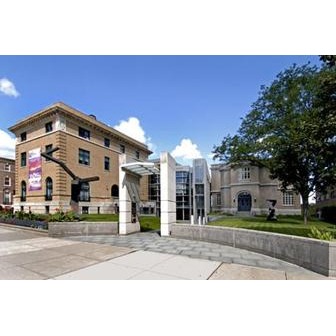Albany Institute of History & Art





Historical Background
Founded in 1791, the Albany Institute of History & Art is one of the oldest museums in the United States. It also is the major repository for the region's heritage, with nationally significant collections. The genesis of the Albany Institute of History & Art began with The Society for the Promotion of Agriculture, Arts, and Manufactures, founded in New York City in Federal Hall. Supported by the New York state legislature, to which it served as an informational advisor, the society met to improve the state's economy through advances in agricultural methods and manufacturing technologies. In accordance with the condition that they meet where the legislature convened, the society moved to Albany in 1797, when it became the state capital.
Recent History
From 1993 to 2000, the Albany Institute raised $17 million to bring the museum galleries and facilities up to twenty-first-century standards with a renovation and expansion project that created the museum you know today. The "new museum" reopened in September 2001. After a six-month search for a new director, the board announced the appointment of David Carroll, effective September 12, 2011. Carroll, who was executive director of the Western Museum of Mining and Industry in Colorado, replaces Christine Miles, who ran the Albany Institute of History & Art for twenty-five years.
Collections of National Significance
The Institute's museum and library holdings form the best collections in the United States documenting the life and culture of the Upper Hudson Valley region from the late seventeenth century to the present day. Although the Institute is famous for its significant Hudson River school paintings, the broad scope of its collections includes fine arts, furnishings, personal objects, documents, manuscripts, photographs, and personal papers used by people of all ages, social classes, economic conditions, and cultural groups. Long-term exhibitions include: "Ancient Egypt," "Nineteenth-Century American Sculpture: Erastus Dow Palmer, Launt Thompson, Charles Calverley," "Sense of Place: Eighteenth- and Nineteenth-Century Paintings and Sculpture," and "Traders and Culture: Colonial Albany and the Formation of American Identity."
Educational Outreach
Education programs serve 10,000 students, teachers, adult learners, and families every year. The museum education department's mission is to connect our community to our collections and exhibitions through lifelong learning opportunities that serve toddlers to older adults. We develop programs for school children and their teachers that provide formal learning experiences that support their curricula. And a full range of informal, public programs for our community helps people of all ages connect to arts and culture and to each other. Every program we offer has been tested and piloted before being fully implemented. Education programs are organized into three areas of learning: schools and teachers programs, public programs, and community and collaborative programs.
Museum Shop
The museum shop is open during regular museum hours and offers a selection of items that reflects current exhibitions, items from the collections, and the work of local artists and craftspeople.
Explore Related Categories







